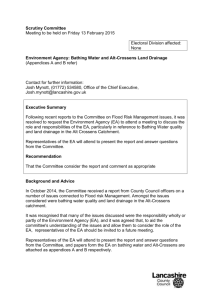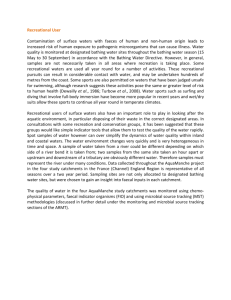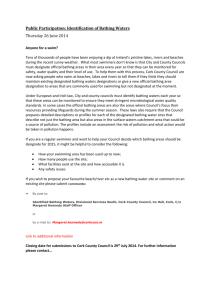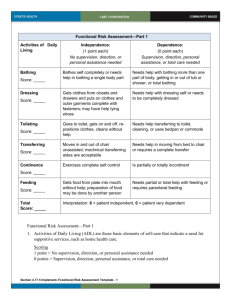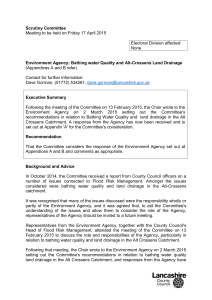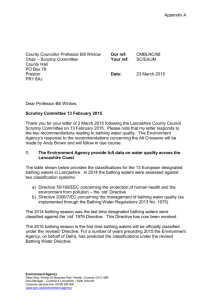Document 12460529
advertisement
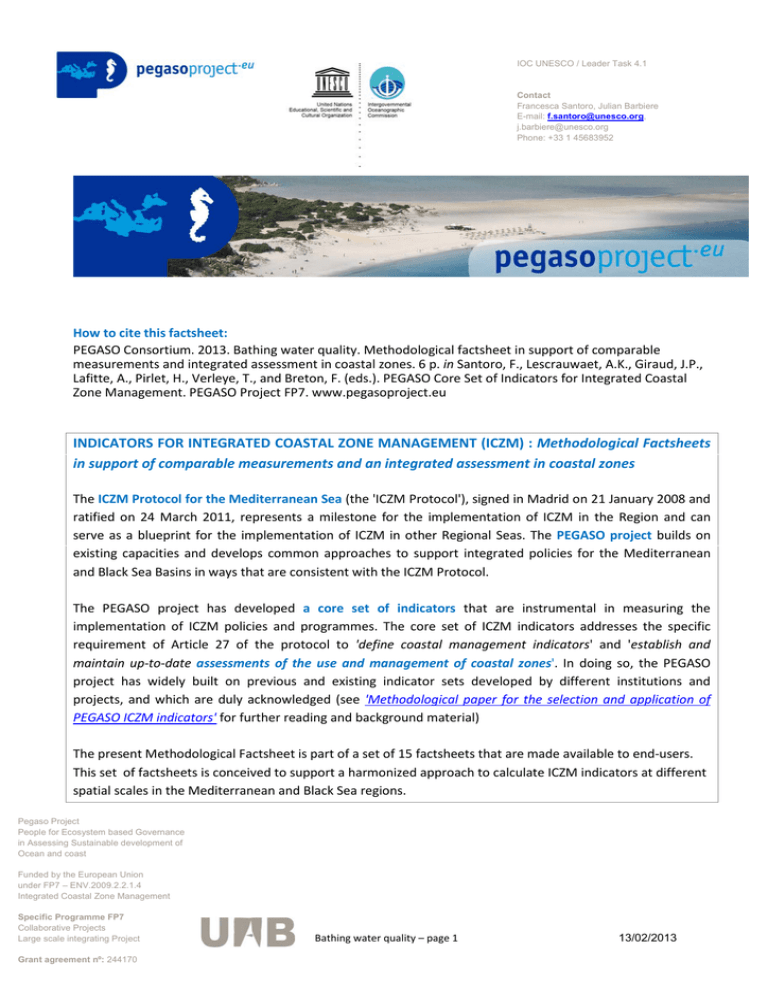
IOC UNESCO / Leader Task 4.1 Contact Francesca Santoro, Julian Barbiere E-mail: f.santoro@unesco.org, j.barbiere@unesco.org Phone: +33 1 45683952 How to cite this factsheet: PEGASO Consortium. 2013. Bathing water quality. Methodological factsheet in support of comparable measurements and integrated assessment in coastal zones. 6 p. in Santoro, F., Lescrauwaet, A.K., Giraud, J.P., Lafitte, A., Pirlet, H., Verleye, T., and Breton, F. (eds.). PEGASO Core Set of Indicators for Integrated Coastal Zone Management. PEGASO Project FP7. www.pegasoproject.eu INDICATORS FOR INTEGRATED COASTAL ZONE MANAGEMENT (ICZM) : Methodological Factsheets in support of comparable measurements and an integrated assessment in coastal zones The ICZM Protocol for the Mediterranean Sea (the 'ICZM Protocol'), signed in Madrid on 21 January 2008 and ratified on 24 March 2011, represents a milestone for the implementation of ICZM in the Region and can serve as a blueprint for the implementation of ICZM in other Regional Seas. The PEGASO project builds on existing capacities and develops common approaches to support integrated policies for the Mediterranean and Black Sea Basins in ways that are consistent with the ICZM Protocol. The PEGASO project has developed a core set of indicators that are instrumental in measuring the implementation of ICZM policies and programmes. The core set of ICZM indicators addresses the specific requirement of Article 27 of the protocol to 'define coastal management indicators' and 'establish and maintain up-to-date assessments of the use and management of coastal zones'. In doing so, the PEGASO project has widely built on previous and existing indicator sets developed by different institutions and projects, and which are duly acknowledged (see 'Methodological paper for the selection and application of PEGASO ICZM indicators' for further reading and background material) The present Methodological Factsheet is part of a set of 15 factsheets that are made available to end-users. This set of factsheets is conceived to support a harmonized approach to calculate ICZM indicators at different spatial scales in the Mediterranean and Black Sea regions. Pegaso Project People for Ecosystem based Governance in Assessing Sustainable development of Ocean and coast Funded by the European Union under FP7 – ENV.2009.2.2.1.4 Integrated Coastal Zone Management Specific Programme FP7 Collaborative Projects Large scale integrating Project Grant agreement nº: 244170 Bathing water quality – page 1 13/02/2013 Name of the Indicator Bathing water quality Objective of the indicator The Bathing Water Directive (76/160/EEC) was designed to protect the public from accidental and chronic pollution incidents, which could cause illness from recreational water use. Examining the compliance with the directive therefore indicates the status of bathing water quality in terms of public health and also the effectiveness of the directive in ensuring safe bathing waters (EEA). The Bathing Water Directive (BWD) is one of the oldest pieces of environmental legislation in Europe and data on compliance go back to the 1970s. Under the directive, Member States are required to designate coastal and inland bathing waters and to monitor the quality of the water throughout the bathing season (EEA). New European legislation on bathing water was adopted in 2006. The ‘New Bathing Water Directive’ updates the measures of legislation and simplifies its management and surveillance methods. The classification of bathing water quality is determined on the basis of a three- or four-year trend instead of a single year’s result, which was the case for the previous Bathing Water Directive. Therefore, the procedure for assessing quality classes of bathing waters under the New Bathing Water Directive gives more reliable and realistic results (EEA). The New Bathing Water Directive is based on scientific knowledge about the protection of health and the environment, as well as on environmental management experience (EEA). The indicator describes the changes over time in the quality of designated bathing waters (inland and coastal) in the EU in terms of compliance with standards for parameters introduced by the EU Bathing Water Directive (76/160/EEC) and the New Bathing Water Directive (2006/7/EC): i.e. microbiological parameters (total coliforms and faecal coliforms) and physicochemical parameters (mineral oils, surface-active substances and phenols) according to the EU Bathing Water Directive (76/160/EEC) and microbiological parameters (intestinal enterococci and Escherichia coli) according to the New Bathing Water Directive (2006/7/EC). The indicator measures the proportion of designated bathing waters in an area that complies with the mandatory standard of quality specified by the EU legislation and the proportion that complies with the more stringent guide standard. The measurement should tell us about any change in quality that has occurred during the past twenty years or so to allow us to assess the effect of improvements in wastewater treatment plants on water quality. Policy context ICZM Policy Objective ICZM Protocol Article UNEP-MAP Ecological Objective INSPIRE ANNEX IIII Data Theme (34) To perform Environmental Impact Assessment for human activities and infrastructures Article 9: Economic activities (Article 9.2.d: Tourism, sporting and recreational activities) Objective 9: Contaminants cause no significant impact on coastal and marine ecosystems and human health Annex III Bathing water quality - page 2 13/02/2013 CALCULATION OF THE INDICATOR Coverage Spatial consideration Resolution – Reporting unit Mediterranean and Black Sea Regions: coastal designated Individual sampling points in designated bathing waters bathing waters (excluding inland designated bathing waters and lakes) Period Temporal consideration Resolution (time interval or unit) Since establishment of the BW Directive in 1976, and at least Annual data (see methodology) since the establishment of the New BWD in 2006 (i) Parameter(s) Annual proportion of bathing waters classified in one of the 6 categories established by the methodology of the Bathing Water Directive. The parameters to be taken into account for assessment according to the assessment rules of the Directive 76/160/EEC are microbiological (1 Total coliforms, 2 Faecal coliforms) and physico-chemical (8 Mineral oils, 9 Surface-active substances reacting with methylene blue, 10 Phenols (phenol indices)). The results are classified and presented according to the following 6 categories on European, regional, national and local level: • CI: Compliant with mandatory values of the Directive for the five parameters; • CG. Compliant with mandatory ànd with more stringent guide values of the Directive for the five parameters; • NC: Not compliant with mandatory values of the Directive for the five parameters; • NF: Bathing waters that are not sufficiently sampled (frequency criteria not satisfied); • NS: Bathing waters that are not sampled due to external causes; • B: Banned or closed (temporarily or throughout the season). Bathing water quality - page 3 13/02/2013 Steps Calculation method Products 1 Record the number of sampling points in each category for Number of sampling points (i) compliant with the guide value the required level (local, sub-regional, regional, national) [blue]; (ii) compliant with the mandatory value [green]; (iii) banned [grey]; (iv) not complying with the mandatory value [red]; and (v) with inadequate sampling frequency [orange]. 2 Divide the number of sampling points compliant with the Percentage of designated coastal bathing waters compliant guide value (blue) by the total number of sampling points with the guide value of the European Bathing Water Directive. (all colours) in each year and multiply the product by 100. 100% stacked column for each year showing the number of sampling points compliant with the guide values as a percentage of the total number of sampling points. A reference value such as the percentage of compliant sampling points for the wider region or the country as a whole should be included. Bathing water quality - page 4 13/02/2013 3 Divide the number of sampling points compliant with the Percentage of designated coastal bathing waters compliant mandatory value (green and blue) by the total number of with the mandatory value only, of the European Bathing Water sampling points (all colours) in each year and multiply the Directive. 1 product by 100 . 100% stacked column for each year showing the number of sampling points compliant with the mandatory values as a percentage of the total number of sampling points. A reference value such as the percentage of compliant sampling points for the wider region or the country as a whole should be included. (4) Data can be aggregated at sub-regional, regional, national and Mediterranean and Black Sea levels using the same formula as shown in Steps 2 and 3. Current monitoring EEA, through national reporting by the member states, Data sources Data are freely available on http://www.eea.europa.eu/themes/water/status-andmonitoring/state-of-bathing-water/bathing-water-dataviewer Assessment context Use of the indicator in previous assessments/initiatives DPSIR framework Link to anthropogenic pressure Sustainability target or threshold Mediterranean Strategy for Sustainable Development (MSSD) coastal indicators The changing faces of Europe’s coastal areas- European Environment Agency EEA (2006) SAIL Schéma d’Aménagement Integrée du Litoral (2006) DEDUCE Développement durable des Côtes Européennes (2007) State All bathing waters to comply with mandatory values in Bathing Water Directive (76/160/EEC). All bathing waters are at least ‘compliant’’ under the New Bathing Water Directive (2006/7/EC) and the number of bathing waters classified as ‘excellent’ or ‘good’ in the New Bathing Water Directive (2006/7/EC) increases. 1 Sampling points attaining the guide value must also have attained the mandatory value. Hence the number of sampling points compliant with the mandatory value in any particular year is the sum of all green and blue-coloured points. Bathing water quality - page 5 13/02/2013 Link with other assessment tools Example of integrated EEA assessment, UNEP-MAP plan Bleu : State of the environment and development in the Mediterranean 2009 assessment Scope for future improvements Methodology uncertainty: There are differences in how countries have interpreted and implemented the directive leading to differences in the representativeness of bathing waters included in terms of recreational water use. These differences may refer to the number, density and location of the sampling stations, the frequency and timing of the sampling. It is important that this information, and any uncertainty in the results, derived from the sampling design, are duly reported and communicated. Data Harmonization: In order to build a common, regional view for a particular indicator, it is crucial to harmonize the data in terms of e.g. concepts, definitions, reporting units, colour codes, value class boundaries and scoring methods. For this purpose, the PEGASO consortium has developed ‘Guidelines for Data Harmonization’ which are available from the ‘Products’ section on the PEGASO project website www.pegasoproject.eu. Although agreements may exist related to the presentation of certain indicators that are legally embedded, this may be less evident for indicators which are not (yet) used as an instrument within a policy context or within a region where the policy is not applicable. The PEGASO consortium encourages contributing partners, stakeholders and end-users to consult the ‘Guidelines for Data Harmonization’ document, and to actively engage in this process. Indicator references (i.e. UNEP, EEA, …) Methodology references • Methodology for bathing water quality assessment in transition period Globevnik, L., Zupan Vrenko, D., Kovačič, M. (2008) Methodology for bathing water quality assessment in transition period. Elaborate. European Environment Agency, European Topic Centre on Water. DEDUCE http://www.deduce.eu/SIF/SIF_16.1.pdf and http://www.deduce.eu/IFS/IFS16.pdf Spatial Data InfrastructureI for ICZM in the South-East Baltic: http://corpi.ku.lt/SDI-4-SEB/state/16.pdf EEA : CSI-022 http://www.eea.europa.eu/themes/water/status-and-monitoring/state-of-bathing-water/bathing-water-data-viewer and http://www.eea.europa.eu/data-and-maps/indicators/bathing-water-quality/bathing-water-quality-assessment-published-3 UNCSD : see bathing_water_quality.pdf on www.un.org/esa/sustdev/natlinfo/indicators/methodology_sheets/oceans_seas_coasts Bathing water quality - page 6 13/02/2013
